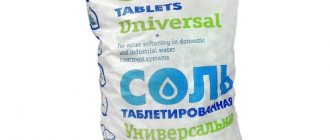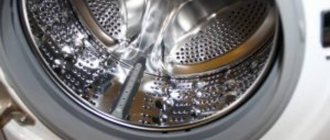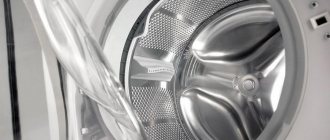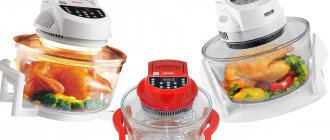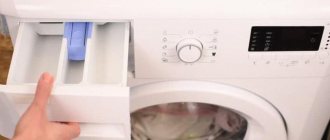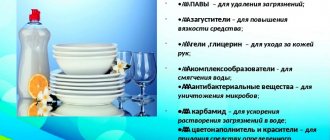The standard three products used for dishwashing include special powder, salt and rinse aid. Each composition has its own purpose, and those who have already mastered a smart unit or are just planning to buy a dishwasher should study the information about it.
Tablets and salt are described in detail in articles on our website, now it’s the turn of the mouthwash. The review includes types, features of the use of compositions, recommendations for choosing brands.
What is it and what is it for?
The dishwasher operates on the principle of conventional hand washing: removing dirt with water and special detergents, and then rinsing. For difficult cases (dried or burnt food residues, soot), pre-soaking is provided. The difference is that all operations are performed by a unit programmed for a specific mode.
The powder is responsible for cleaning and washing, but afterwards detergent residues, stains, and drops remain on the surface of the kitchen utensils. Rinse aid for dishwashers - a liquid concentrate loaded into a special compartment - should remove them.
The best rinse aids for your dishwasher
Initially, many buyers underestimated the importance of rinse aids for dishwashers. In fact, this substance helps protect dishes from stains, giving them newness and shine.
Concentrated detergents need to be removed as much as possible from the surface of cutlery at the end of the wash. The rinse aid protects against aggressive influences and eliminates chemical residues. The rating includes high-quality branded products with optimal characteristics and prices.
Topper
This product will help completely remove chemical residues and odors from the surface of the dishes. The composition also guarantees protection against streaks, stains, and a faster drying process. This in turn promises energy savings during operation of the device. Topperr has a pleasant, unobtrusive scent, and one package contains 500 ml of rinse aid. The main purpose prescribed by the manufacturer is to combat greasy film, stains, smudges, and protect the device from scale and rust.
Advantages
- No chemical smell;
- Multifunctionality;
- Machine protection;
- Minimum consumption;
- Inexpensive price tag.
Flaws
- Modest bottle volume;
- Inconvenient dispenser.
Compared to many rinse aids, the efficiency of cleaning, protecting dishes from stains and darkening is much higher. One bottle is enough for approximately 250-300 cycles with a small volume, which confirms the cost-effectiveness. Some buyers complain about the inconvenient dispenser, which is why pouring takes some getting used to.
Paclan Brileo
The world-famous CeDo brand offers high-quality, easy-to-use and environmentally friendly detergents, among which Paclan rinse aid received the highest praise. Its effective formula contains non-ionic active-surfactants, preservatives, as well as a component with antibacterial biocidal activity. Regular use will protect the device from scale and deposits, completely remove detergent residues, stains, and greasy shine from cutlery, giving them shine and newness.
Advantages
- Unobtrusive smell;
- Antibacterial action;
- Versatility;
- Unique formula;
- Inexpensive price tag;
- Convenient bottle shape.
Flaws
- Far from being the safest composition;
- Need for dose adjustment.
Users most often approve of how shiny and clean their dishes come out of the sink. Since the composition contains preservatives and non-ionic surfactants, some buyers are wary of this.
Types of rinse aids
A typical product is a concentrated liquid, which includes: a surfactant complex, acids (lactic, citric, succinic), polycarboxylates, defoamers (ethers and alcohols), tensides. This is a standard set of components, but different ones, so you can find out the exact composition from the description on the product packaging.
Funds are divided into three types:
- direct use (removing detergent from dishes, adding shine);
- multifunctional (contains additives that prevent the formation of limescale on machine elements and protect against scale);
- eco-products (hypoallergenic), containing natural components that do not cause negative reactions in people with hypersensitivity to “chemicals”.
Security requirements
The main thing that everyone who uses conditioner for PMM should remember is the rules for storing detergent. In this case, you need a dry, dark place. If you have children, be sure to take care of the sealed container, and it is better to place the product away from the child’s hands, since the substance can leave burns and cause serious poisoning if ingested.
Since rinses contain powerful organic acids, it is important to minimize contact with the skin. For what? It's simple: contact with the skin of even an adult can cause a burn or an allergic reaction.
Rinsing process
The product begins to work after the washing phase, and (depending on the program) a first and second rinse may be performed. The composition is not involved in the washing process, so it is poured into a specially designed compartment, usually located on the dishwasher door. There are also compartments for tablets, salt, and powder.
On a note! Do not add rinse aid to the detergent compartment!
Where to fill
The concentrate compartment is located on the inside of the unit door and is indicated by the symbols: “snowflake”, “sun”.
The composition is poured into a special hole, and the manufacturers have provided a rotating mechanism with a scale. By adjusting the level of rinse aid consumption is set.
Typically, the scale initially has factory settings, and already during the washing process, users themselves regulate the consumption of the product. This depends on the degree of contamination of the dishes, water hardness, and washing mode.
Dosages
In discussions on numerous forums, questions about the consumption of rinse aid often arise. Filling of the product is carried out strictly according to the instructions for the PMM. The standard option is the maximum. If an unsatisfactory result is obtained (whitish spots, smudges on kitchen utensils), the dosage is reduced using the regulator; if drying is poor, the dosage is increased.
It is convenient if the bottles have a dispenser cap with a spout, then the gel does not spill. Any liquid that does not get into the hole must be removed with a dry cloth.
The rinse aid is consumed gradually, and if the compartment is filled to capacity, there is no need to load it before each wash. To monitor the level of rinse concentrate, small windows or control indicators (visual or electrical) are provided.
PanelPMM Bosch
PMM Hotpoint Ariston
For cars of the brands Siemens, Bosch, Gorenje, Hansa, Whirlpool, Zanussi, Electrolux ) designation of the rinse aid compartment and the icon near the indicator on the control panel - “asterisk”; for Asko models (“Asko”) - “drop”; Hotpoint Ariston has a cross.
If the product starts to run out, the lights light up (you need to replenish the supply). As soon as the rinse aid is added, the indicator will go out. In the instructions for the units, the processes for adding detergents are given step by step, with a detailed explanation, so the user can only carefully study the recommendations and follow them.
Where is the rinse aid compartment usually located?
Each front-loading washing machine, for example, from Bosch, is equipped with a retractable tray for detergents with three compartments, and they differ in shape, size and even location relative to each other. Their purpose is as follows:
- compartment for adding bleach and powders intended for soaking laundry. It is small and is usually designated by the letter A or the Roman numeral I;
- compartment for powder used for the main wash. This compartment is designated by the letter B or number II. It is the largest and is used constantly, since washing powder is poured into it in any mode;
- air conditioning compartment. This is the narrowest compartment, since the rinse aid is a concentrated product and you need to pour only a little, literally a third of the cap. The fact that this is a compartment for fabric softener can be determined by the image in the form of a flower next to it - in models from this compartment is always designated this way. It may have a blue color, or it may be simply white. This compartment can also be equipped with a removable tray, but this option is not present in models from every company.
It is worth noting that the flower is not the only icon to designate the compartment intended for the air conditioner in the washing machine. In Lg models, this compartment may be marked with an asterisk.
When the optional assembly of a particular model does not provide a third compartment dedicated to conditioner, it can be poured directly into the drum, but only after the main wash cycle has completed.
To do this, you need to select the no-rinse mode, open the door at the end of the wash and send a cap with a small amount of conditioner to the laundry.
It is not recommended to pour it directly onto wet things - stains and streaks may remain on the clothes.
Among the models of washing machines, there are some that, when you first get acquainted with them, you can easily get confused in deciding where to pour the air conditioner. Here are some of them:
- On the ELECTROLUX EWW51486HW model, the rinse aid compartment is the far right compartment in the chemical tray. It looks unusual, since you need to pour the product through the hole covering the lid compartment.
- Top-loading washing machines can also be confusing, and the Bosch WOT24455O model can cause confusion, since the detergent container is located right on the lid, and the fabric softener compartment is in the middle.
- The machines are equipped with a tray in which the conditioner compartment is located on the right, while the product is poured into a small hole in the middle of it.
- Samsungecobubble is also capable of surprising the average person with an unusual type of container for detergents. It has only two compartments, the right one is blue and is divided into two additional compartments. The compartment that is closer when opening the tray is designed to fill in the rinse aid.
- Some top-loading models have four compartments in a container located under the lid. The one on the right is for rinse aid.
- Siemens washing machines are very practical in this regard, since the compartments for air conditioner and bleach are covered with lids. At the same time, the compartments on top are marked with a flower and a bottle, respectively.
If you follow basic logic, it will not be difficult to determine which container to pour the conditioner into.
It is worth noting that each washing machine model has a maximum permissible level of liquid rinse aid.
Upon completion of washing, the tray must be removed and washed so that the holes through which powders and liquids are supplied are not clogged with their residues.
That's all the recommendations on where to pour the rinse aid when washing.
It is difficult to confuse the compartments in the tray, even if there are no markings - they all have different sizes - just remember that the smallest compartment is intended for the air conditioner.
We suggest you familiarize yourself with What to do if an item becomes colored during washing: tips and tricks
There is no need to be afraid that the product will get into the laundry at the very beginning of the wash - a working washing machine uses the conditioner as intended and on time. The rinse aid compartment will not empty until the main wash cycle has finished.
Whether to use air conditioner for a washing machine or not is everyone’s choice. There are special liquids for wool and delicate fabrics, there are hypoallergenic rinses for children's laundry, and there are also concentrates. In any case, it doesn’t hurt to know where to add fabric softener, because you need to be on familiar terms with your home appliances.
Popular brands
The table shows products that have earned positive reviews and are in demand among customers.
| Brand | Functional | Peculiarities | Price | |||
| Removing streaks | Adding shine | Anti-scale protection | Water softening | |||
| Finish (Poland) 800 ml | + | + | + | + | Does not contain phosphates, chlorine | 380-400 rub. |
| Somat (Germany) 750 ml | + | + | + | + | Without chlorine and phosphates | 280-320 rub. |
| Clean & Fresh (Czech Republic) 500 ml | + | + | — | — | Free from phosphates and chlorine. Economical | 130-180 rub. |
| Sodasan (Germany) 500 ml | + | + | + | + | Without toxic components, biodegradable. Reduces drying time for kitchen utensils, protects metal objects from oxidation | 520-570 rub. |
| Frosch (Germany) 750 ml | + | + | + | + | Without chlorine and phosphates. Biodegradable. No animal testing has been performed. Suitable for washing at low water temperatures | 350-400 rub. |
| Paclan (Belgium) 500 ml | + | + | + | + | Without chlorine, fragrances, phosphates | 150-190 rub. |
| CleanOK (Turkey) 500 ml | + | — | — | — | Contains preservatives | 80-120 rub. |
| Bioretto (Russia) 500 ml | + | + | — | — | The composition does not contain chlorine, phosphates, or fragrances. Suitable for use in houses with a septic tank | 170-190 rub. |
| Synergetic (Russia) 750 ml | + | + | + | + | Does not contain chlorine, phosphates. Biodegradable. Neutralizes unpleasant odors. Unscented | 180-210 rub. |
| VAILY 550 ml | + | + | + | + | Concentrate, does not contain phosphates. Biodegradable | 150-200 rub. |
| “Cinderella” (Russia) 500 ml | + | + | — | — | No fragrance. Not suitable for heavy soiling | 140-160 rub. |
| Eona Eonit (Russia) 500 ml | + | + | — | — | Without chlorine and phosphates | 120-150 rub. |
Top best options for dishwashers
Over the entire period of production of products of this type, several of the most popular ones have stood out. They wash dishes perfectly and almost never leave residue or other marks on the dishes.
Finish Reckitt Benckiseer
This product is preferred not only by ordinary users, but also by dishwasher manufacturers. Finish provides excellent and fast removal of grease and dirt stains not only from dishes, but also from the surface of the walls of the machine. Despite many positive reviews, the products are expensive.
Sodasan
Contains gentle soap ingredients. The rinse aid reduces drying time several times, does not contain harmful surfactants, and does not allow oxidation of the internal parts of dishwashers. After the washing process is completed, no chemical smell remains on the dishes or inside the machine.
Somat (Henkel)
It has no disadvantages and is used as economically as possible due to the presence of a convenient dispenser. Does not leave a pronounced odor on the dishes. All surfactants included are considered safe and protect dishes from plaque.
Top House (Interos GmbH)
It does not have the most reliable packaging, with the dispenser constantly opening. It has a relatively high price. Contains hydroponics that enhance cleaning properties. The composition also contains a small amount of citric acid, which makes the product less aggressive compared to its competitors.
Paclan Brileo (CeDo)
The manufacturer claims that the product is safe and environmentally friendly, but it still contains surfactants within the permitted limits. It has an antibacterial effect and protects the internal parts of the dishwasher. Cleans old dishes from dirt and is economical to use. Compared to other competitors, it has an affordable price and a convenient dispenser.
Frosch
If the dose recommended by the manufacturer is exceeded, it is poorly washed off from the dishes, leaving an unpleasant residue. It is economically used, and the patented form of cleaning ensures the brightness and shine of kitchen utensils.
Clean Home (Himros)
A domestic product, practically in no way inferior in quality to foreign analogues. It has a distinct odor, which many find unpleasant and intrusive. Cleans dishes without problems, protecting internal elements only from scale formation.
It is better to buy rinse aids recommended by dishwasher manufacturers. They have tested such products and guarantee their quality.
Is it possible to do it yourself?
Many enterprising housewives know how to replace expensive compounds at home. Use vinegar and citric acid, mixing the components in certain proportions.
Here are a couple of recipes:
- Take any essential oil, glass cleaner and citric acid. The ratio is 2:1:5. Gently mix the product and add 1 teaspoon to the special compartment before washing. This amount is enough for 6-7 cycles (depending on how dirty the dishes are and the degree of water hardness). You cannot exceed the norm or change the proportions.
- Apple cider vinegar (9%) is poured into the compartment, amount - 1 tablespoon. One dose is enough for 5-6 cycles.
How to replace dishwasher rinse aid
- If an allergy occurs when using factory-made drugs;
- To reduce the cost of household chemicals;
- In order to protect yourself from the chemical components of modern products.
Most often, people tend to save money - not everyone is ready to pay as much as 500 rubles for a bottle of a safe product.
To make a simple mouthwash, we need a liter of water in which we need to dissolve a small amount of citric acid (costs 60-70 rubles per 1 kg, enough for a whole barrel of mouthwash), a couple of tablespoons of alcohol and any essential oil (sold at the pharmacy). If you want to avoid the smell, you don’t have to add oil. Pour the finished rinse aid into the appropriate dispenser of the dishwasher.
We will build the second product using any glass cleaner, lemon juice (you can use a solution of citric acid) and essential oil - the juice is mixed with the glass cleaner in a ratio of 5 to 1, the amount of oil is a few drops. Pour the finished rinse aid into the dishwasher and start the next cycle.
In the simplest case, you can get by with apple cider vinegar. Some people claim that regular table vinegar will do, but it doesn’t have a very pleasant smell. Therefore, it is best to make a homemade preparation based on lemon juice. But we do not recommend using glass cleaners - some of them are more dangerous than any other store-bought rinses.
Please note that when using homemade household chemicals, you risk voiding your warranty and causing damage to your dishwasher
Can I use washing powder?
Before the advent of effective special products for washing large and difficult-to-clean dishes, housewives used to use washing powder - it easily cleaned off any dirt. However, it absolutely cannot be used in PMM because:
- Creates a lot of foam - it interferes with high-quality washing;
- Contains toxic substances that remain on the surface of the plates even after repeated rinsing. If you wash dishes with powder and then heat food in it in a microwave oven, you can get poisoned or have an allergic reaction.
Is there any point in staying away from chemo?
Why look for substitutes for products produced specifically for PMM? Someone may recall the feminine logic - they say, buy an expensive dishwasher so as not to waste time washing dishes, and then refuse ready-made substances and manually prepare their substitutes.
But the truth, as always, lies in the golden mean - there are moments that should not be forgotten. Reasons why some dishwasher owners refuse "chemistry":
- You should only buy special products for PMM. And this is expensive.
- They contain substances that adversely affect the body.
- The natural product is not only environmentally friendly, but also inexpensive.
How much money does it cost per year?
Saving is one of the arguments for creating “folk recipes”. What amounts are we talking about? Costs depend on the type of special equipment:
- Tablet preparations - 6,000 rubles;
- Gel or powder product - 2000-3000 rubles. But when using them, you also need a rinse aid - plus 1000 rubles. Total 4000-5000 rubles.
A small family spends the same amount to pay for electricity for six months. There is a reason to think about saving.
Pros and cons of the product
The main advantages of rinses include the following:
- Adding brightness and shine to dishes.
- Reducing water hardness.
- Acceleration of the drying process.
- Increased machine service life.
- Protection of dishwasher elements from limescale.
- Washing off the main detergent component.
When manufactured with high quality, products of this type have no negative aspects. But with a large quantity and low quality of the product, it can leave traces and poorly wash off plaque, which has a bad effect on the appearance of the dishes and the operation of the dishwasher.
Conclusions and useful video on the topic
The universal product is not included in the TOP in terms of efficiency and environmental priorities, but it is attractive because it is suitable for rinsing in any type of dishwasher:
A properly selected rinse aid will help wash the greasy plates, dirty cups and other kitchen utensils as cleanly as possible, speed up the drying of dishes and protect the metal parts of the dishwasher from limescale deposits and corrosion.
Such a purchase will not greatly affect the family budget. The product is used sparingly, and even the most expensive bottle will last for at least 150 washing sessions.
Would you like to tell us about the rinse composition you have chosen? Share your reasons for choosing the best product. Please leave comments in the block below, ask questions, post photos on the topic of the article.
How to use dishwasher rinse aid
During the repair of both washing machines and dishwashers, quite common, but, frankly speaking, stupid mistakes people make are revealed. When using rinse aids, they don’t think at all about where they need to pour it, because in most cases it turns out that they pour it in the same place where they add the powder. It turns out that the rinse aid intended for the dishwasher is simply wasted, because if you pour it in the wrong place, you will not achieve any effect.
- How to use dishwasher rinse aid
- Types of rinse aids for dishwashers
- Components of a commercial rinse aid
- How to make your own mouthwash
First of all, it must be said that before using and operating a dishwasher, as well as any other household appliance, you need to carefully and thoroughly study the instructions, which spell out all the basic rules for using a particular device, the purpose of all the “buttons” and functions, correct loading of dishes into it. And of course, all the elements and parts of the machine will probably be schematically drawn there, including the compartment intended for the rinse aid.
The rinse aid is consumed at the very final stage of washing, so if it gets into the water tank much earlier, it will not have any effect. It is also important to understand that rinse aid is not just a freshener or removes unpleasant chemical odors from dishes after the washing procedure. It also has the following features:
- remove stains and drops of water from dishes;
- minimize the contact of parts and elements of the dishwasher with acids, alkalis and other components of chemical detergents that can harm the dishwasher;
- give the dishes a special shine, cleanliness and whiteness.
How to choose the right one
Pay attention to the composition. Standard dishwasher detergent contains:
- Surfactant complexes that bind dirt and grease and then remove them from the surface. Tensides improve wettability and create a protective layer using the surface tension of H2O. This reduces drying time and saves electricity.
- The harder the tap water, the higher the percentage of detergents it should contain. Anionic sulfates (petroleum distillates) are the cheapest and pose the greatest danger to the human body. But amphoteric and nonionic ones are the least dangerous. The latter are 100% biodegradable.
- Polycarboxylates - protect the internal mechanisms of the unit from oxides and rust.
- Acids (citric, succinic, salicylic and lactic), which neutralize aggressive chemical components.
- Various alcohols and ethers act as defoamers for surfactants, preventing excess foam from stopping the operation of the machine. They are additional degreasers and flavoring agents.
All alkalis in the rinse aid have a whitening effect. This means that colored dishes will fade over time. If you have a lot of similar cutlery, give preference to the minimum dosage of sodium hypochlorite.
Buy powder and mouthwash from the same brand. The manufacturer has already taken care of the optimal composition of working components that will fulfill their purpose 100%.

